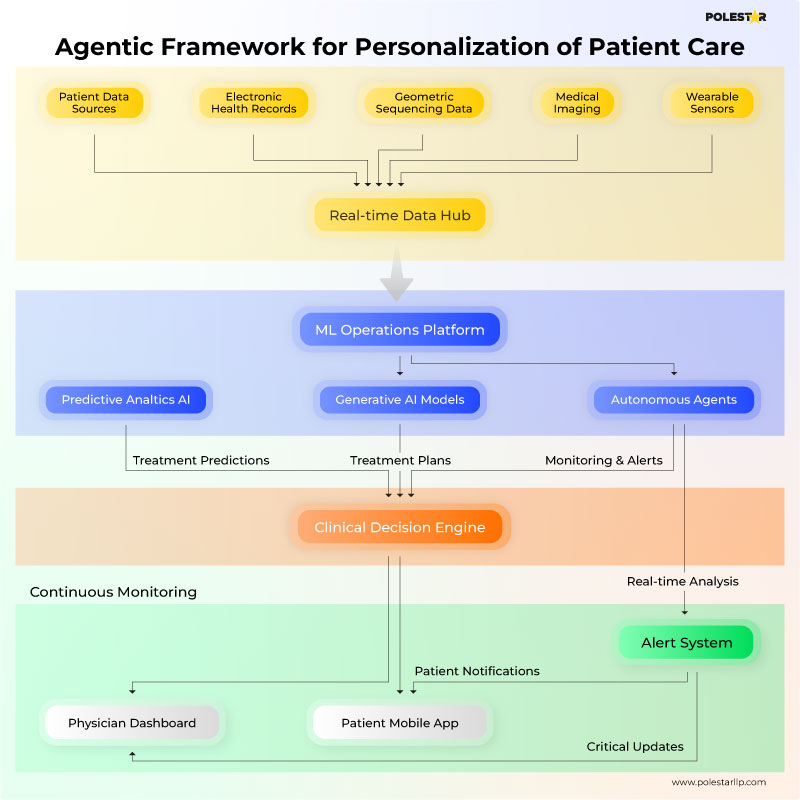
Sign up to receive latest insights & updates in technology, AI & data analytics, data science, & innovations from Polestar Analytics.
✔ How Agentic AI and Generative AI are changing the landscape of Pharma!
✔ Discuss the architecture and framework of Top 3 Agentic AI Use cases in Pharma: Rare Disease Identification & Sales Mapping Agent, Patient Care personalization agent, and Anomaly detection agent.
✔ Pre-requisites of getting started with Agentic AI for pharma
From even 3D printing drugs to developing drugs with the help of generative AI, pharma and life sciences industry has come a long way.
It is estimated that by 2025, over 180 zettabytes of data will be generated globally, with healthcare contributing more than one-third. We’ve moved away from talking about big data in pharma to talking about building AI applications is more important than ever because the potential is now unlimited—especially when exploring agentic AI use cases in pharmaceutical industry, from drug discovery to patient engagement.
Generative AI itself was expected to produce $60 billion to $110 billion in annual value across the pharmaceutical value chain. Now think about the value that the combination of Agents, Generative AI, and Statistical modelling techniques can bring!
To successfully adopt agentic AI in pharma, companies must first build strong data foundations and integration readiness. This enables autonomous systems to drive efficiency across R&D, trials, and supply chains.
Though the emphasis of good data has always been there, now is high time to increase focus on data representation and storage. Cloud infrastructure is not just a ‘should-have’ but a ‘must-have’, and there’s a need to take it a step further with choosing the right format of storage like Lakehouse, One Lake, etc.
For instance, consider a data-related question about annual sales. Instead of having the same model perform every task—right from querying data, formatting results, and generating responses—Agentic AI in Pharmaceuticals can,
Agentic AI in Pharmaceuticals is not static; it needs to be monitored regularly to validate results as conditions evolve. Not only does this require a lot of time and effort technically, but it also demands significant education and time from a change POV. It is important to educate the leaders and users about model drift, latency, and other challenges/benefits of AI Agents.
There are many possible agentic AI use cases in life sciences, especially within the pharma industry—ranging across drug discovery, clinical trials, manufacturing, commercial sales, marketing, and compliance. These intelligent systems are redefining how life sciences organizations innovate, operate, and scale.
| Use Case | Generative AI | Agentic AI |
|---|---|---|
| Drug Discovery and Development | In silico compound screening Large molecule design Knowledge extraction |
Autonomous research agents Personalized medicine design |
| Clinical Trials | Synthetic data generation Patient recruitment |
Trial optimization Real-world data analysis |
| Manufacturing & Supply Chain | Process optimization Predictive maintenance |
Autonomous supply chain management Quality control automation |
| Commercial & Marketing | Personalized content creation Chatbots and virtual assistants |
Sales force automation Market analysis and forecasting |
| Regulatory & Compliance | Document generation Compliance monitoring |
Automated regulatory submissions Auditing and risk management |
But for the sake of better understanding, well talk about 3 of them.
Not every doctor is Dr. House. It’ll be practically impossible to identify rare diseases based on the patient test data.
Let’s take the example of a Dr. Daniel & Patient: Erika who has a rare disease ‘ABC’. We’re trying to help improve her QoL by promptly identifying the patterns in the test and bring attention to Dr. Daniel with the right treatment course.

With an orchestrator agent managing the entirety of all sub-agents, you can not only plan subsequent activities with your sales team and track follow-ups, but also leverage the best agentic analytics platforms for pharma sales analytics to drive smarter, real-time decisions across the commercial function.
Looking to kick start your Agentic AI for Pharma journey? Get a free demo of our Agentic AI bots!
Talk to AI Experts
Wearables are now bringing us healthcare data that can improve patient data like never before. The sample Agentic Framework (below) for patient care represents a next-generation approach to personalized healthcare delivery, integrating multiple data streams through a real-time hub.

At its core, the framework leverages three key AI components: Predictive Analytics AI for treatment forecasting, Generative AI Models for treatment planning, and Autonomous Agents for continuous monitoring and real-time analysis.
This specialized agent can:
Another type of agent we’re working on is the Anomaly detection agent which monitors production processes in real-time and identify potential issues before they lead to equipment failure or quality problems. It ingests data from a network of IoT sensors across the production floor, monitoring variables such as:
The agent pre-processes the data for signal filtering and monitoring. Through multiple detection methods including statistical analysis, machine learning models, and pattern recognition algorithms it identifies three types of anomalies: Point Anomalies, Contextual Anomalies, and Collective Anomalies.
The intelligent decision system can identify the root cause analysis to give priority-based alerts & generate automated response protocols.
This model also highlights the need for continuous monitoring and feedback loops to check for model drifts and accuracy at regular intervals while keeping in compliance with the industry standard.
The era where you’re still thinking about whether or not you need AI is long gone.
You need to get started with it. Pronto.

If you are stuck anywhere on this journey of getting started with Agentic AI use cases for pharmaceutical industry, don’t worry we’re here to help!
Our pharma and tech experts will guide you to accelerate your Agentic AI journey sooner. Just drop us a message and we’ll get back to you.
About Author

Data & BI Addict
When you theorize before data - Insensibly one begins to twist facts to suit theories, instead of theories to suit facts.